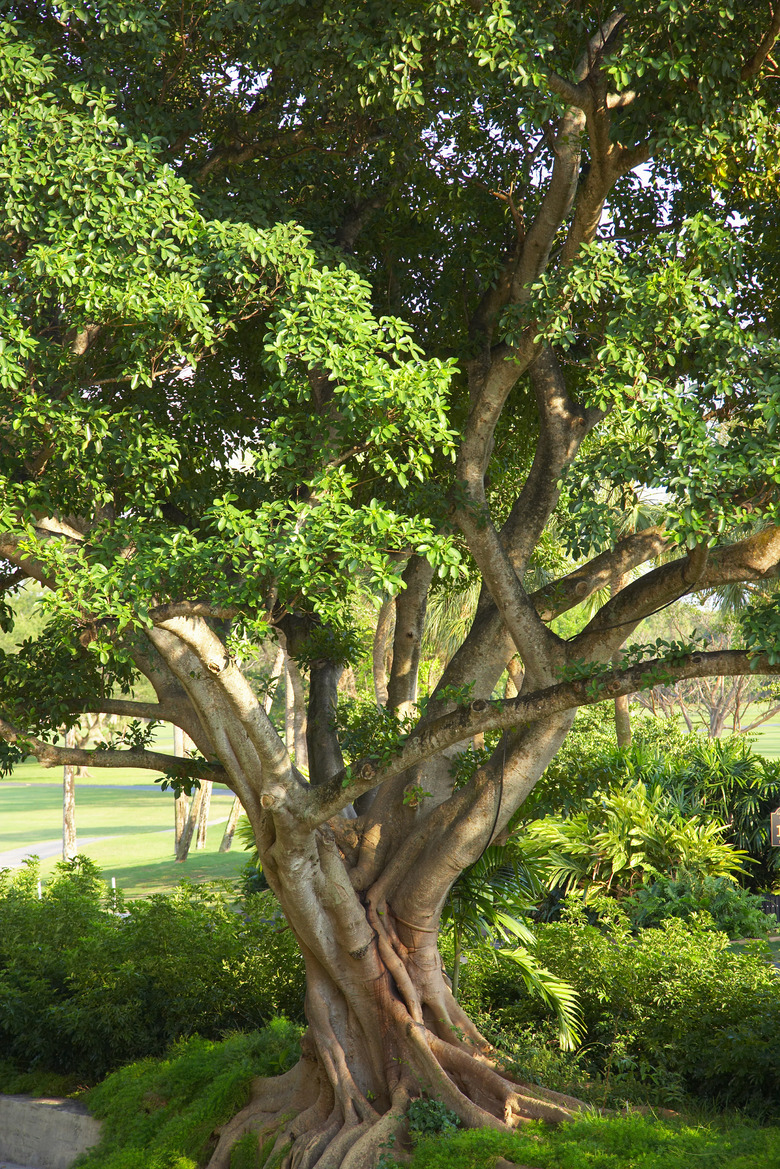What Is The Problem If My Ficus Tree Leaves Are Brown At The Tips?
There are over 800 species of Ficus, including well-known trees like the rubber tree and the weeping fig. These trees, which are native to India and Asia, are known for their glossy, leathery leaves that seem to drop every time their environment changes. However, if your ficus leaves are turning brown at the tips, it's probably due to moisture problems, a lack of nutrients or disease.
Step 1
Ficus plants are native to tropical areas and need medium to high humidity. If the leaves are turning yellow or developing brown tips and margins, they may be suffering from dry air. A room humidifier will add moisture to the air, or you can place your tree container on a tray of gravel. Add water to the tray, but keep the level of the water just below the top of the gravel layer so your tree isn't sitting in water.
Watering
Step 1
Improper watering is another reason why leaf tips turn brown. Ficus trees should be watered with room-temperature water until the water pours through the drainage holes. Drain off excess water in the tray. Most ficus plants should be allowed to dry a little in between waterings. One exception is the creeping fig, which needs to be watered as soon as the surface of the soil dries.
Step 2
- Ficus plants are native to tropical areas and need medium to high humidity.
- Ficus trees should be watered with room-temperature water until the water pours through the drainage holes.
Fertilizing
Step 1
A lack of iron or potassium can also turn leaf tips brown. Iron deficiency also causes older leaves to yellow, and brown areas may appear between the veins or on the margins. Your tree will also produce fewer leaves. Symptoms of potassium deficiency include the appearance of dead spots between veins and at the tips of the leaves. New leaves will be small and yellow with green veins. In addition, leaves may drop. Exposure to chlorinated or fluoridated water can also cause browning. Flush the soil to remove excess fluoride from the soil. Ficus trees should be fertilized every three or four weeks during periods of active growth. The strength of the fertilizer should be half what is recommended on the label.
Step 2
- A lack of iron or potassium can also turn leaf tips brown.
- Iron deficiency also causes older leaves to yellow, and brown areas may appear between the veins or on the margins.
Anthracnose
Step 1
Anthracnose is a fungal disease that causes dark brown spots to appear anywhere on the leaves, including on the tips. Look for slightly sunken spots with dark brown margins. As the disease progresses, large areas may turn brown, and the leaves will drop. Masses of yellowish spores develop in the diseased areas. Control anthracnose by removing diseased leaves. Avoid overhead watering and reduce stress from water and heat.
Botrytis
Step 1
Botrytis blight is a fungal infection that causes brown spots with concentric rings to appear on the leaf tips or between the leaf and sheath. It's mainly a problem for rubber plants, during cool weather. As the disease progresses, affected areas wilt and collapse. Grayish-brown fungal threads and spores develop on the spots when the humidity is high. The spores are spread by wind and water and may infect healthy leaves if they are wet. Control botrytis by removing dead and diseased leaves and burning or burying them. Fungicides can be applied as a protectant.
Step 2
- Anthracnose is a fungal disease that causes dark brown spots to appear anywhere on the leaves, including on the tips.
- Botrytis blight is a fungal infection that causes brown spots with concentric rings to appear on the leaf tips or between the leaf and sheath.
Cercospora
Step 1
Cercospora is another fungal disease that can cause ficus leaves to die, starting at the tip. Look for reddish-brown spots on the leaves, especially along the margins and leaf tips. As the disease progresses, the spots grow bigger and the center of the spot turns light brown with a brown margin and yellow halo. Control cercospora by removing diseased leaves. Avoid getting the leaves wet, and prune to improve air circulation and encourage drying.
References
- North Carolina State University; Indoor Plant Selection And Care; Douglas A. Bailey; August 1999
- University of Florida: Ficus Production Guide; R.W. Henley, et. al.
- North Dakota State University Extension Service; Questions on Ficus; Ron Smith
- North Dakota State University Houseplants; Proper Care and Management of Pest Problems; Janet J. Knodel, et. al.; p. 6
- University of California Statewide Integrated Pest Management Program: Identification and confirmation – Mineral deficiency
